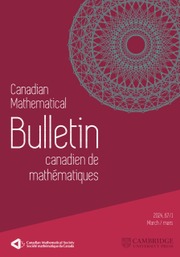No CrossRef data available.
Article contents
Vanishing Fourier Transforms and Generalized Differences in  $L^{2}(\mathbb{R})$
$L^{2}(\mathbb{R})$
Published online by Cambridge University Press: 16 October 2018
Abstract
Let  $\unicode[STIX]{x1D6FC},\unicode[STIX]{x1D6FD}\in \mathbb{R}$ and
$\unicode[STIX]{x1D6FC},\unicode[STIX]{x1D6FD}\in \mathbb{R}$ and  $s\in \mathbb{N}$ be given. Let
$s\in \mathbb{N}$ be given. Let  $\unicode[STIX]{x1D6FF}_{x}$ denote the Dirac measure at
$\unicode[STIX]{x1D6FF}_{x}$ denote the Dirac measure at  $x\in \mathbb{R}$, and let
$x\in \mathbb{R}$, and let  $\ast$ denote convolution. If
$\ast$ denote convolution. If  $\unicode[STIX]{x1D707}$ is a measure,
$\unicode[STIX]{x1D707}$ is a measure,  $\unicode[STIX]{x1D707}^{\star }$ is the measure that assigns to each Borel set
$\unicode[STIX]{x1D707}^{\star }$ is the measure that assigns to each Borel set  $A$ the value
$A$ the value  $\overline{\unicode[STIX]{x1D707}(-A)}$. If
$\overline{\unicode[STIX]{x1D707}(-A)}$. If  $u\in \mathbb{R}$, we put
$u\in \mathbb{R}$, we put  $\unicode[STIX]{x1D707}_{\unicode[STIX]{x1D6FC},\unicode[STIX]{x1D6FD},u}=e^{iu(\unicode[STIX]{x1D6FC}-\unicode[STIX]{x1D6FD})/2}\unicode[STIX]{x1D6FF}_{0}-e^{iu(\unicode[STIX]{x1D6FC}+\unicode[STIX]{x1D6FD})/2}\unicode[STIX]{x1D6FF}_{u}$. Then we call a function
$\unicode[STIX]{x1D707}_{\unicode[STIX]{x1D6FC},\unicode[STIX]{x1D6FD},u}=e^{iu(\unicode[STIX]{x1D6FC}-\unicode[STIX]{x1D6FD})/2}\unicode[STIX]{x1D6FF}_{0}-e^{iu(\unicode[STIX]{x1D6FC}+\unicode[STIX]{x1D6FD})/2}\unicode[STIX]{x1D6FF}_{u}$. Then we call a function  $g\in L^{2}(\mathbb{R})$ a generalized
$g\in L^{2}(\mathbb{R})$ a generalized $(\unicode[STIX]{x1D6FC},\unicode[STIX]{x1D6FD})$-difference of order
$(\unicode[STIX]{x1D6FC},\unicode[STIX]{x1D6FD})$-difference of order $2s$ if for some
$2s$ if for some  $u\in \mathbb{R}$ and
$u\in \mathbb{R}$ and  $h\in L^{2}(\mathbb{R})$ we have
$h\in L^{2}(\mathbb{R})$ we have  $g=[\unicode[STIX]{x1D707}_{\unicode[STIX]{x1D6FC},\unicode[STIX]{x1D6FD},u}+\unicode[STIX]{x1D707}_{\unicode[STIX]{x1D6FC},\unicode[STIX]{x1D6FD},u}^{\star }]^{s}\ast h$. We denote by
$g=[\unicode[STIX]{x1D707}_{\unicode[STIX]{x1D6FC},\unicode[STIX]{x1D6FD},u}+\unicode[STIX]{x1D707}_{\unicode[STIX]{x1D6FC},\unicode[STIX]{x1D6FD},u}^{\star }]^{s}\ast h$. We denote by  ${\mathcal{D}}_{\unicode[STIX]{x1D6FC},\unicode[STIX]{x1D6FD},s}(\mathbb{R})$ the vector space of all functions
${\mathcal{D}}_{\unicode[STIX]{x1D6FC},\unicode[STIX]{x1D6FD},s}(\mathbb{R})$ the vector space of all functions  $f$ in
$f$ in  $L^{2}(\mathbb{R})$ such that
$L^{2}(\mathbb{R})$ such that  $f$ is a finite sum of generalized
$f$ is a finite sum of generalized  $(\unicode[STIX]{x1D6FC},\unicode[STIX]{x1D6FD})$-differences of order
$(\unicode[STIX]{x1D6FC},\unicode[STIX]{x1D6FD})$-differences of order  $2s$. It is shown that every function in
$2s$. It is shown that every function in  ${\mathcal{D}}_{\unicode[STIX]{x1D6FC},\unicode[STIX]{x1D6FD},s}(\mathbb{R})$ is a sum of
${\mathcal{D}}_{\unicode[STIX]{x1D6FC},\unicode[STIX]{x1D6FD},s}(\mathbb{R})$ is a sum of  $4s+1$ generalized
$4s+1$ generalized  $(\unicode[STIX]{x1D6FC},\unicode[STIX]{x1D6FD})$-differences of order
$(\unicode[STIX]{x1D6FC},\unicode[STIX]{x1D6FD})$-differences of order  $2s$. Letting
$2s$. Letting  $\widehat{f}$ denote the Fourier transform of a function
$\widehat{f}$ denote the Fourier transform of a function  $f\in L^{2}(\mathbb{R})$, it is shown that
$f\in L^{2}(\mathbb{R})$, it is shown that  $f\in {\mathcal{D}}_{\unicode[STIX]{x1D6FC},\unicode[STIX]{x1D6FD},s}(\mathbb{R})$ if and only if
$f\in {\mathcal{D}}_{\unicode[STIX]{x1D6FC},\unicode[STIX]{x1D6FD},s}(\mathbb{R})$ if and only if  $\widehat{f}$ “vanishes” near
$\widehat{f}$ “vanishes” near  $\unicode[STIX]{x1D6FC}$ and
$\unicode[STIX]{x1D6FC}$ and  $\unicode[STIX]{x1D6FD}$ at a rate comparable with
$\unicode[STIX]{x1D6FD}$ at a rate comparable with  $(x-\unicode[STIX]{x1D6FC})^{2s}(x-\unicode[STIX]{x1D6FD})^{2s}$. In fact,
$(x-\unicode[STIX]{x1D6FC})^{2s}(x-\unicode[STIX]{x1D6FD})^{2s}$. In fact,  ${\mathcal{D}}_{\unicode[STIX]{x1D6FC},\unicode[STIX]{x1D6FD},s}(\mathbb{R})$ is a Hilbert space where the inner product of functions
${\mathcal{D}}_{\unicode[STIX]{x1D6FC},\unicode[STIX]{x1D6FD},s}(\mathbb{R})$ is a Hilbert space where the inner product of functions  $f$ and
$f$ and  $g$ is
$g$ is  $\int _{-\infty }^{\infty }(1+(x-\unicode[STIX]{x1D6FC})^{-2s}(x-\unicode[STIX]{x1D6FD})^{-2s})\widehat{f}(x)\overline{\widehat{g}(x)}\,dx$. Letting
$\int _{-\infty }^{\infty }(1+(x-\unicode[STIX]{x1D6FC})^{-2s}(x-\unicode[STIX]{x1D6FD})^{-2s})\widehat{f}(x)\overline{\widehat{g}(x)}\,dx$. Letting  $D$ denote differentiation, and letting
$D$ denote differentiation, and letting  $I$ denote the identity operator, the operator
$I$ denote the identity operator, the operator  $(D^{2}-i(\unicode[STIX]{x1D6FC}+\unicode[STIX]{x1D6FD})D-\unicode[STIX]{x1D6FC}\unicode[STIX]{x1D6FD}I)^{s}$ is bounded with multiplier
$(D^{2}-i(\unicode[STIX]{x1D6FC}+\unicode[STIX]{x1D6FD})D-\unicode[STIX]{x1D6FC}\unicode[STIX]{x1D6FD}I)^{s}$ is bounded with multiplier  $(-1)^{s}(x-\unicode[STIX]{x1D6FC})^{s}(x-\unicode[STIX]{x1D6FD})^{s}$, and the Sobolev subspace of
$(-1)^{s}(x-\unicode[STIX]{x1D6FC})^{s}(x-\unicode[STIX]{x1D6FD})^{s}$, and the Sobolev subspace of  $L^{2}(\mathbb{R})$ of order
$L^{2}(\mathbb{R})$ of order  $2s$ can be given a norm equivalent to the usual one so that
$2s$ can be given a norm equivalent to the usual one so that  $(D^{2}-i(\unicode[STIX]{x1D6FC}+\unicode[STIX]{x1D6FD})D-\unicode[STIX]{x1D6FC}\unicode[STIX]{x1D6FD}I)^{s}$ becomes an isometry onto the Hilbert space
$(D^{2}-i(\unicode[STIX]{x1D6FC}+\unicode[STIX]{x1D6FD})D-\unicode[STIX]{x1D6FC}\unicode[STIX]{x1D6FD}I)^{s}$ becomes an isometry onto the Hilbert space  ${\mathcal{D}}_{\unicode[STIX]{x1D6FC},\unicode[STIX]{x1D6FD},s}(\mathbb{R})$. So a space
${\mathcal{D}}_{\unicode[STIX]{x1D6FC},\unicode[STIX]{x1D6FD},s}(\mathbb{R})$. So a space  ${\mathcal{D}}_{\unicode[STIX]{x1D6FC},\unicode[STIX]{x1D6FD},s}(\mathbb{R})$ may be regarded as a type of Sobolev space having a negative index.
${\mathcal{D}}_{\unicode[STIX]{x1D6FC},\unicode[STIX]{x1D6FD},s}(\mathbb{R})$ may be regarded as a type of Sobolev space having a negative index.
MSC classification
Information
- Type
- Article
- Information
- Copyright
- © Canadian Mathematical Society 2018

